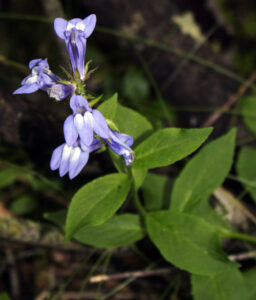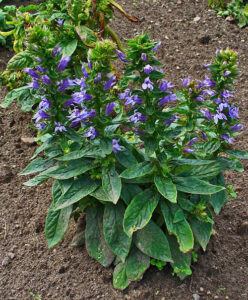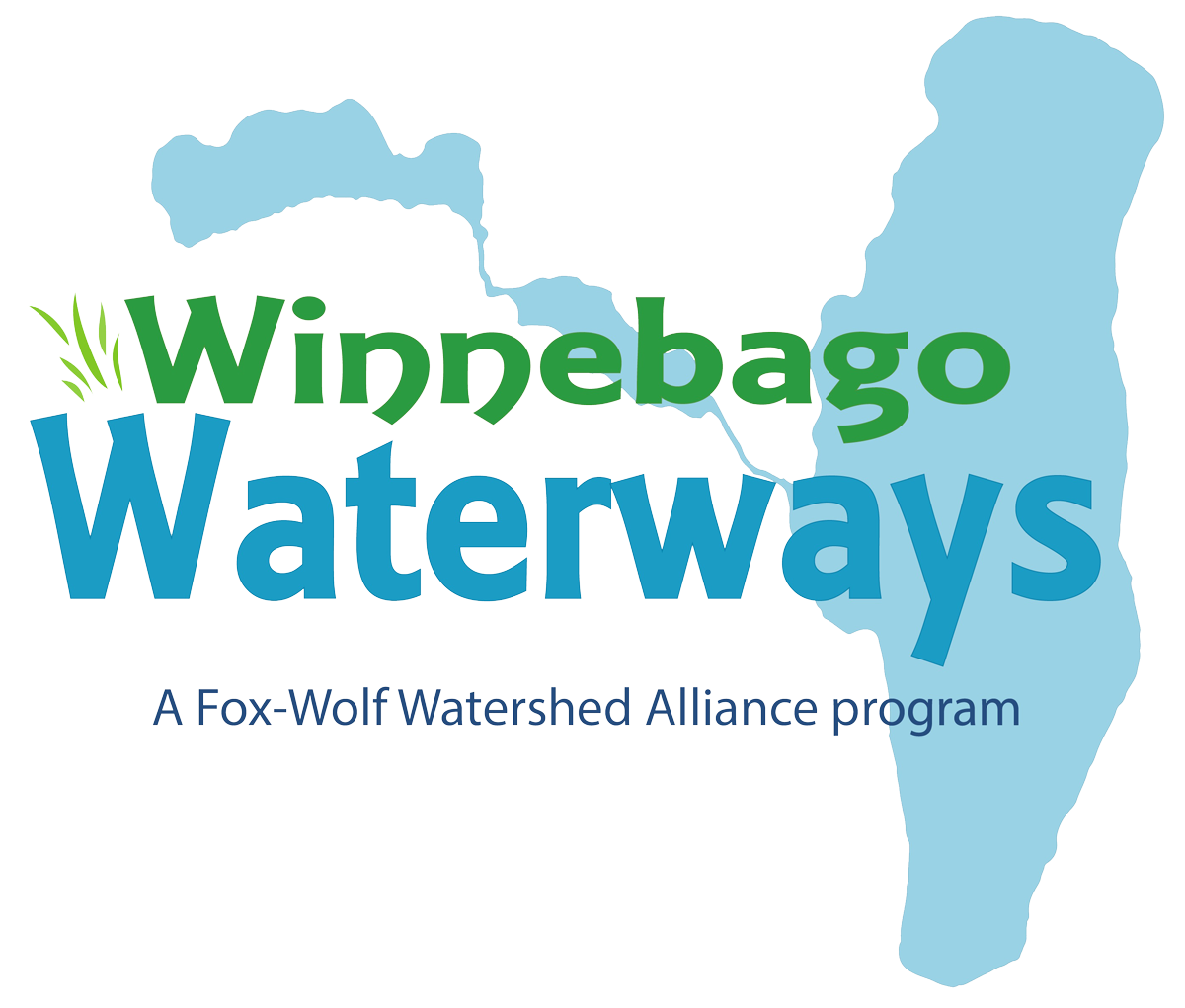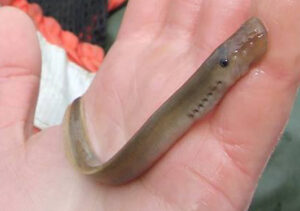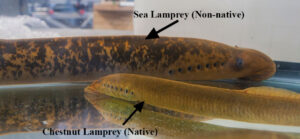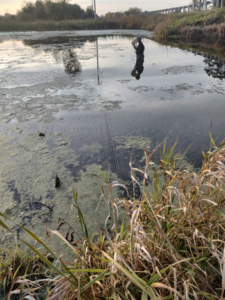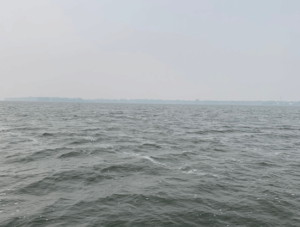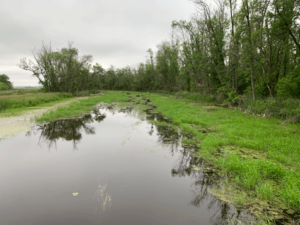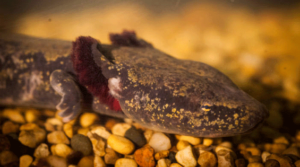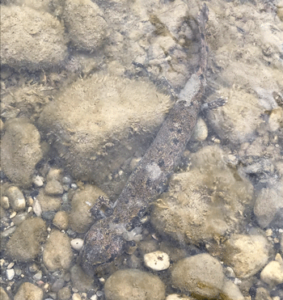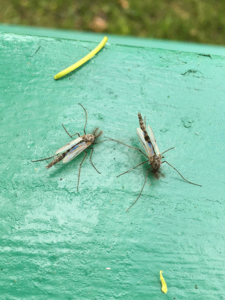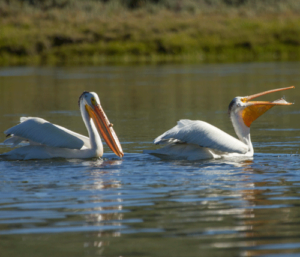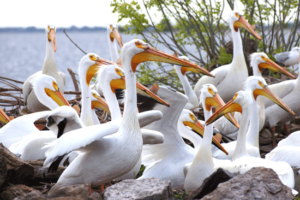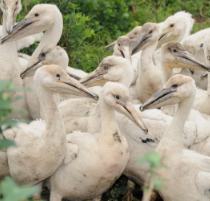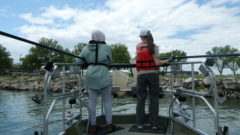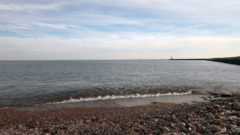Gina LaLiberte: blue-green algae in Wisconsin’s waters
Gina LaLiberte: blue-green algae in Wisconsin’s waters
Gina LaLiberte is a true clean water champion who has studied algae in local lakes for two decades. She is a research scientist with the Wisconsin Department of Natural Resource’s Bureau of Science Services and serves as the Statewide Harmful Algal Bloom Coordinator.
Wisconsinites and tourists see big wooden signs at the borders of our state that say “Welcome to Wisconsin” and highlight recreation, along with industry and agriculture as highlights of our state. Summer recreation, unfortunately, has limits on some of our lakes’ beaches when algae blooms and bacteria prompt health department closures.
Gina explains what blue-green algae is, how it gets in our lakes and rivers, and what we can do to stay safe during summer recreation.
The interview was featured on the VMO Show on Monday, July 21 on 98.7 WVMO-FM in Monona, WI. This episode of the VMO Show was hosted by River Alliance of Wisconsin’s Communications Director, Stacy Harbaugh.
Full interview text
Stacy: Welcome to the VMO show. I’m your host, Stacy Harbaugh, and in the studio with me today is Gina LaLiberte. Gina is an expert on algae in lakes. She’s been studying algae for about 20 years, I believe, maybe longer. 30 years. 30 years She’s been studying algae, why it gets into our lakes, what it does, why it’s a problem, and what we can do about it. So, I’m really looking forward to a conversation with her in advance of her talk at the Clean Lakes Alliance event that’s coming up on Tuesday and we’ll give you details about that in a moment. So, please join me in welcoming Gina LaLiberte. Welcome to the WVMO Studios, Gina.
Gina: Thank you so much for having me.
Stacy: Fantastic. Well, tell me a little bit more about your role at the Department of Natural Resources and how you got into studying algae in lakes.
Gina: Sure. Well, I am currently serving as the statewide harmful algal bloom coordinator for the Wisconsin Department of Natural Resources. And while that might sound like I I go out and make blooms happen, it’s more of a a response to blooms. So, I lead communication in response to blooms, I get bloom reports from the public, from other staff at DNR, from county partners and other partners throughout the state, and do a lot of outreach to to groups, especially this summer, right? I’ve been doing a lot of outreach to different groups all over Wisconsin about blue-green algae and other types of algae.
Stacy: Well, there’s a lot to talk about since we have so many lakes, especially in our listening area, and Wisconsin’s known for its wonderful lakes, and we’ve got to keep them clean. So, in this case, a bloom is a bad thing, right? This is not like a garden bloom. This is a form of pollution, like a natural form of pollution in our lakes. Would you say that that’s true?
Gina: Yeah, that that is that is a good way to to think about it. So, normally there’s there’s going to be algae, including blue- green algae, growing in every water body in Wisconsin. There’s just no such thing as a lake or river that doesn’t have them. And they normally just quietly mind their own business, do their own algae things. But if there are a lot of nutrients like nitrogen and phosphorus in the water, that can fertilize their growth. It can fertilize the growth of other types of algae and aquatic plants, too. But if the blue-green algae really start to take off, they grow to really high levels, most for the most part, you can see a bloom when it when it’s growing. It looks like sort of greenish water, other discoloration in the water or scums or mats floating on the water. And that’s what a bloom is.
Stacy: That sounds pretty gross. Probably something we don’t want in our lakes. So, why is this a bigger problem for our lakes besides being something that’s not really good to look at?
Gina: Well, it does have those aesthetic issues. It’s really not fun to look at, and when blooms start to decompose, it can be really stinky and almost smell like sewage sometimes. Ecologically, decomposing blooms can create problems for wildlife. If there’s a large enough bloom that is decomposing, it uses up a lot of the oxygen as the bacteria decompose it and that can lead to reduced oxygen level that can result in fish kills. If fish just can’t move out of the area. So there’s a lot less oxygen for them to use up and unfortunately they die.
Stacy: Yeah, that’s that’s bad for the health of our lakes, but also that’s bad for people when it comes to having us access these lakes for recreation, for enjoyment. Tell me a little bit about why perhaps a swimming beach might be closed because of an algae bloom.
Gina: Sure. Well, one of the big concerns that we have with blue-green algae is that some of them can make toxins. Now, not all blue-green algae can make toxins, and even those that do don’t make them all the time, but it’s sort of a problem if you’re at the beach and you see a bloom because you can’t tell if a bloom is making toxins just by looking at it. So there has to be beach testing, but in general, if you see a bloom present, you really need to be cautious and you definitely want to avoid swallowing water that contains that bloom or if you are say water skiing or tubing on a lake, you can be exposed by inhaling water droplets. So, you really want to avoid bloom areas on a lake if you’re, say, going really fast and creating a spray and tubing or skiing.
Stacy: Wow. That’s something I never think about. I always think of stagnant water as being the places where, you know, where to avoid those blooms. I never think about water skiing or some of those more active forms of recreation. I’m just sad when a beach is closed, you know, and we do face that in the Monona area, in Dane County, you know, and in other places in the State of Wisconsin. You know, these beaches are very are very special to us. And, you know, you don’t need a country club membership to go swim at a beach, but we do need to make sure that they’re safe before we go in. So, we’ll talk about that a little bit more a little deeper into the show. So you talked about the presence of nutrients in in water and nutrients are in water too all the time. But where do these nutrients come from?
Gina: Well, for the most part nutrients there are there’s going to be some nutrients just present in lakes from historical inputs, but there are inputs coming into lakes all the time and they’re coming from the land. So everything that’s upstream is possibly going to end up coming into the lakes via runoff. And unfortunately when we have like really heavy rain events like we did recently that can bring a lot of nutrients into the lakes.
Stacy: Yeah, we’ve had a lot of rain this summer. In fact, uh, at my day job, I am the communications director for River Alliance of Wisconsin. And we recently had one of our flagship events, the Fools’ Flotilla, which is where a bunch of people get into costumes and they decorate their boats, their kayaks, their canoes, and travel down the Yahara River in order to go to the Waterfront Festival. Super fun event, but every single year, not only do we have to watch the weather for the day of the event, but we’ve got to keep an eye on how the weather is leading up to it because there have been algae blooms even in, you know, the Yahara River. We think of blooms as being more of a lake issue, but they do occur in rivers as well. So, you know, we don’t want our event to be ruined by an algae bloom, but but we always have to keep our our eyes open for that, too.
So Gina, you’ve been studying this for a long time. What is it about algae that sparked your scientific research interests?
Gina: Well, I originally started out studying fish and then I took an algae course at a field station and I reversed course and started to to work on algae. They’re just there’s so many cool and beautiful algae out there and it’s really magical to just put just a drop of water under a microscope and look at it because I never know what I’m going to see. Sometimes it’s old friends, sometimes it’s things I’ve never seen before. So, it’s it’s really an adventure on a a tiny scale for me.
Stacy: And what does algae look like under a microscope? Can you describe it?
Gina: Oh gosh, there are so many diverse shapes. There are some green algae called desmids that have all sorts of crazy shapes like stars and fat little triangles, snowflakes even. Even some of the the blue-green algae are really cool. There are some filaments that are motile. They can crawl around. So, it’s a lot of fun to see these guys moving around under the microscope. And I don’t know, it’s it sounds like a weird thing. And I actually thought, “Oh, algae, that’s not that not that interesting.” But after I took this field course, obviously, I changed my mind.
Stacy: Well, that’s amazing. And we need scientists like you to, you know, fall in love with the subject enough to stay focused on it because it really is such a long… it’s a big, complex problem, right? When we have too much algae in our lakes and we need scientists who are passionate to to keep on it and to keep that research going, to know what’s out there and to help us inform uh some of the solutions to you know when it when it becomes a problem and it is it is a big problem. It’s not just when our beaches close. It’s much more complex than that. So I was wondering if you had some advice on what people, whether they’re listeners right now, or what community leaders can do to solve this problem when there’s too much algae in our lakes and we have these algae blooms.
Gina: Well, once once the nutrients get into a lake, it’s very very hard to take them out. So, preventing nutrient input into the lakes is is really essential. So that can be at large scale like doing different municipal projects to reduce kind of widescale runoff or even if you are a lakeside homeowner or you you live in a neighborhood where you know that part that portion of the watershed drains into the lakes. You can do things like installing rain gardens, uh, infiltration projects, minimizing fertilizer use on your lawn, and even minimizing herbicide use, too, and salt use because all of those things can help to contribute to blue-green algae blooms. Blue-green algae are more tolerant of salt. So, the more salt that gets into a lake, it’s the more desirable kinds of algae that are better foods for little microorganisms and fish, they don’t do as well. But blue-green algae do. Same with herbicides. Blue-green algae are less susceptible to herbicides than other more desirable kinds of algae. So, herbicide use, if you have herbicides washing from your property into a lake, that’s not good good news for the lake. And the blue green algae don’t care. They’ll just keep on growing.
Stacy: And they’re tough.
Gina: They are.
Stacy: They’re very tough. Here in the City of Monona, they’ve been taking their lakeside responsibilities very seriously as well. In fact, in June, the city council had a meeting that received some reports on their storm water and wastewater plans. And so they’ve been the the plan commission has been doing a lot of work to try to address what’s coming out of the the culverts, what’s coming out of the pipes and the connections to our lakes. They used to have really bad outfalls, those discharge points where water comes from from off of surfaces, off of everything from land to streets to sidewalks, all of that. Everything that washes off and goes into the lakes, it really wasn’t clean water back in the day. And so they’ve been working a lot with planning both above ground and below ground to have more green infrastructure, but also the city of Monona has been doing a lot of investing into changes in just their infrastructure and trying to green that up. So, Schluter Park was one, Stone Bridge Park, the latest project in Kelly Place. These are all projects trying to lower the a number the volume of this these particulates or this, you know, any of those nutrients that are getting into our lakes as as well as trash. But there’s some other programs too that listeners might want to know about. Just getting your leaves picked up in the fall. Not having those things go into the gutters and go into the storm drains. That’s a really big thing. Keeping your trash contained helps. The Salt Wise program is something that’s a great program in the state to educate, you know, anyone who’s got a sidewalk that needs salt, right? That’s W I Salt Wise dot com. You can find more information about Salt Wise Wisconsin. And yeah, the City of Monona’s programs for leaf-free streets and adopt-a-drain programs. These are all programs to help keep some of the stuff that feeds algae out of the lakes and contained where they should be. And of course, we can all use, like you said, lower fewer pesticides and chemicals on our yard, so we can all do our part. Any other thoughts on sort of the big picture on what we can do as a as a whole community beyond just our listening area? What we can do in Wisconsin to keep our lakes clean?
Gina: Well…
Stacy: It’s a big it’s a complex problem, right? And this these are, you know, algae is tough, right?
Gina: It is a big problem, but there are a lot of different programs going on all throughout the state. In particular, there are a lot more farmer-led groups. Farmers want to keep the nutrients on the land because it’s expensive to apply fertilizers when you’re growing crops. So, there are a lot of farmer-led initiatives that are that are happening throughout the state. And they’re getting a lot of good participation with with farmers. And these are peer-to-peer groups. It’s not someone in the government telling them “you should do this.” It’s farmers encouraging other farmers. And there’s a lot of friendly competition involved, too. If you’ve got better yield using better management practices for a field, your fellow producers see that and they want to do that, too.
Stacy: That’s good. Well, that’s good that that information is being exchanged and it’s a it’s a complex problem, but we can all do our part.
Welcome back to the VMO show. I’m your host Stacy Harbaugh, and in the studio with me is Gina LaLiberte. She’s the DNR’s expert on algae and algae blooms and all things algae in our lakes. And she’s here to talk to us about why our beaches close and how we can swim safely this summer. So what do you think? What’s your best advice for people who want to go swimming in our local lakes, maybe bring their dog? What’s the best way that they can swim safely and not get into trouble with algae blooms?
Gina: I think the the best thing you can do is to look at the water before you go in, before you let the kids go in, definitely before you let the dog go in. So, if it looks questionable, then you might want to pick a different beach to swim at. When it comes to blue-green algae, we quite often have a lot of blooms accumulating at downwind shores. Blue-green algae float and so they’re really easily moved around by wind. So, if you are deciding on what beach to head out to in the day, look at the weather forecast and look at what the wind direction is. If the wind is quite often out of the south or the southwest in the summer, then the beaches at the the north and the northeast shore of a lake might be more affected than the beaches towards the south or the southwest end of the lake. So, pay attention to the wind direction and always look at the water before you go swimming. So, if you see water that has a lot of little tiny green particles in that, that is very possibly blue green algae. If you see floating scums, that’s definitely not good conditions to swim in. And we are really lucky in Dane County that the Public Health Madison Dane County, our public health department, does a lot of beach testing. So, they test both for E.coli bacteria at the beaches, but they also do testing for blue-green algae and they test for toxins at the beaches. So, they have a great website that shows the recent testing results for all of the beaches. They even have an email signup where you can just get those, any beach closures automatically delivered to you by email. So, we’re really lucky to have them working for us to offer this in Dane County.
Stacy: Yeah, that’s really helpful, especially if you’re busy parents and you want some place to take the kids, you want someplace safe to swim. Uh, that’s a great website. So, that’s public health M D C dot com and that’s where you can go and look up beach and lake water quality and sign up for those email alerts. If you’re an avid swimmer, that’s an essential piece of information.
So, Gina, you’re giving a talk in the community here pretty soon. Tell us more about what’s happening with the Clean Lakes Alliance.
Gina: Sure. Well, Tuesday, July 22nd, I’m giving a talk at the East Side Club for the Clean Lakes 101 program. So, I’m going to be talking about blue-green algae in our lakes in in Dane County. It’s going to kind of be a general look at at blue-green algae, but also looking specifically at some of the blooms that we’ve been having in in lakes right around Madison and Monona.
Stacy: Well, good. So, if you want to dig into this topic a little bit more, then please join Gina and the Clean Lakes Alliance at the East Side Club on Tuesday, July 22nd. Learn more about what’s going on in our lakes, especially our beloved Lake Monona. Well, thank you so much for tuning in to this episode of the VMO show. I hope you get to swim a little bit this summer, someplace with a nice safe beach, an algae-free beach. That’s what we hope for. And tune in to the next episode of the VMO show where we talk about community events and what’s going on in the Monona area. Thanks for listening. Drive safe and we’ll see you next time.
– Stacy Harbaugh, Communications Director
This message is made possible by generous donors who believe people have the power to protect and restore water. Subscribe to our Word on the Stream email newsletter to receive stories, action alerts and event invitations in your inbox. Support our work with your contribution today.
The post Gina LaLiberte: blue-green algae in Wisconsin’s waters appeared first on River Alliance of WI.
Blog - River Alliance of WI
https://wisconsinrivers.org/gina-laliberte-algae/

 I’m in a new role as “She Who Takes Care of the Wild Rice,” our most precious gift. Peter and Lisa David previously worked with the Great Lakes Indian Fish & Wildlife Commission as wildlife and Manoomin biologists and retired about three years ago. GLIFWC reorganized and created two roles: wetland ecologist and my position that integrates traditional knowledge and culture to build relationships with rice chiefs and tribal communities to give a voice to manoomin.
I’m in a new role as “She Who Takes Care of the Wild Rice,” our most precious gift. Peter and Lisa David previously worked with the Great Lakes Indian Fish & Wildlife Commission as wildlife and Manoomin biologists and retired about three years ago. GLIFWC reorganized and created two roles: wetland ecologist and my position that integrates traditional knowledge and culture to build relationships with rice chiefs and tribal communities to give a voice to manoomin.  How I see it, manoomin are other beings that experience how the weather can shift in our seasons. It’s happening today. Climate change has extreme water fluctuations, from extreme rain and flooding, to less snowpack and droughts. This impacts rivers and streams, which shifts the channels of water going into rice water bodies. When there is a slower movement of water, we see things like lily pads and other native plants encroaching on rice. Those who work with manoomin recognize its sensitivity. We have estimated that nearly half of the historic range of manoomin has been lost due to habitat loss, decreased water quality and human activity where it had once thrived for thousands of years.
How I see it, manoomin are other beings that experience how the weather can shift in our seasons. It’s happening today. Climate change has extreme water fluctuations, from extreme rain and flooding, to less snowpack and droughts. This impacts rivers and streams, which shifts the channels of water going into rice water bodies. When there is a slower movement of water, we see things like lily pads and other native plants encroaching on rice. Those who work with manoomin recognize its sensitivity. We have estimated that nearly half of the historic range of manoomin has been lost due to habitat loss, decreased water quality and human activity where it had once thrived for thousands of years.  Non-tribal members can play a crucial role in protecting manoomin. They can contribute by learning and respecting our indigenous knowledge, but they have knowledge themselves that they can share. It can be a cultural exchange. They can educate themselves about the cultural significance of manoomin to our communities, especially to Ojibwe people, and learn about the spiritual and ecological importance of this native grain. They can advocate for legal protections and support initiatives like the Rights of Manoomin like Minnesota is doing. They can advocate for legal protections in other parts of the state.
Non-tribal members can play a crucial role in protecting manoomin. They can contribute by learning and respecting our indigenous knowledge, but they have knowledge themselves that they can share. It can be a cultural exchange. They can educate themselves about the cultural significance of manoomin to our communities, especially to Ojibwe people, and learn about the spiritual and ecological importance of this native grain. They can advocate for legal protections and support initiatives like the Rights of Manoomin like Minnesota is doing. They can advocate for legal protections in other parts of the state. 